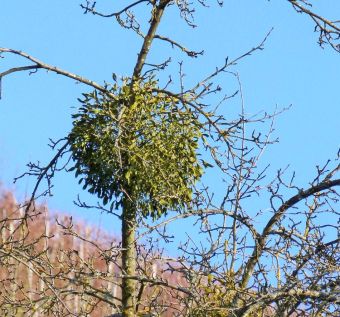
If runners develop athlete’s foot, what do rocket scientists develop? –Mistletoe. So goes a bad joke. Most people are familiar with the use of the mistletoe tree parasite in holiday celebrations. The history behind such use is readily available online. But just what is mistletoe? How does it grow? And what is mistletoe good for? Let’s check it out.
Mistletoe Tree Parasite
There are many varieties of mistletoe. They grow as independent globular clusters in tree branches and some shrubs. As a result, mistletoe in trees becomes most visible in cold weather, when leaves fall. Although the plants largely subsist on nutrients produced by the host plant, mistletoe does produce some of its own food via photosynthesis. So officially it is a hemiparasite, which means half parasite.
It’s for the Birds
Mistletoe serves as food for certain birds. Some eat the shoots and leaves, others the berries. The ‘seeds,’ coated with a sticky substance formed in the bird, are deposited on the bark of branches of the host. Germination produces tiny root-like structures that invade the host to withdraw nutrients from it.
Mistletoe’s Beneficent Presence
Birds are not limited to eating mistletoe berries solely. The same birds eat the berries of other plants. All the seeds, indiscriminately, are eliminated via the bird’s feces in the same area as the mistletoe host tree. This results in biodiversity. This is because different tree varieties invite different wildlife.
Health Benefits
What about direct benefits for humans? Research is ongoing, but studies suggest mistletoe has antioxidant potential for use in medicines and may find application in lowering blood sugar and cholesterol.
Also, mistletoe extracts may be useful in fighting cancer. Moronic acid, found in mistletoe, is being evaluated for suitability in fighting HIV and herpes simplex.
Note: You might also enjoy The Chocolate Alkaloid Theobromine
References:
- Science Direct: Evaluation of Chemical Properties of Mistletoe Leaves…
- National Cancer Institute: Mistletoe Extracts…
← Back to Food and Health
← Home